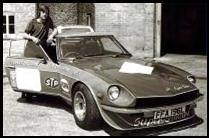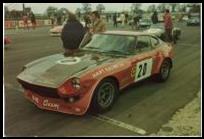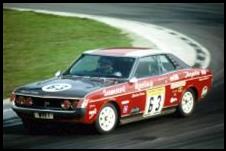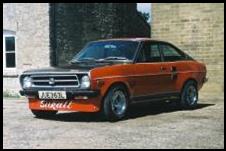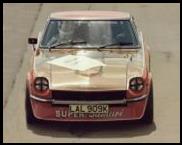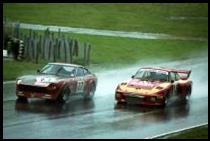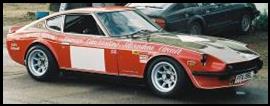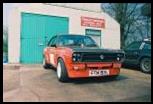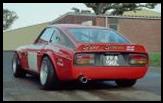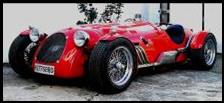

|
SAMURI HISTORY. -------------------------------- Like so many things that happen in life, SAMURI as a commercial exercise really started by accident. Spike Anderson, ex public schoolboy and semi pro Dixieland trumpet player, had been in the high performance business for some years, three of which he had been at Broadspeed as a cylinder head specialist and, in 1973, in his mid 30´s, he decided to go it alone. He had owned a string of Austin Healeys, (including a 300BHP Chevy V8 powered one) and, after first acquiring a 1971 Datsun Sunny Coupe, modifying it into a quick little car, calling it a SAMURI®, he traded it in for a new Datsun 240Z, as it was the nearest thing he could find to his much loved Healey 3000s at the time. The new car, whose UK registration number was FFA196L was, and, 47 years on, still is universally known as FFA. Its potential was patently obvious and he, with the help of various ex Broadspeed mates, comprehensively modified it. They even gave it a special paint job and, fairly logically, called it a SUPER SAMURI. It was sign-written to advertise his new company “RACE HEAD SERVICES” and that, really, was that. That is of cause, until Clive Richardson of “MOTOR SPORT magazine” saw it, and wrote two feature articles. The phone started ringing and Spike commenced producing replicas thus beginning the production of now 77 Super Samuri’s, the road race versions mostly known by the first three letters of their UK registration numbers. It was as a customer that Win Percy first met Spike who watched him Hill Climb his Super Samuri, realising immediately that he had witnessed an awesome talent. During the course of 1973 ten Super Samuris were built for Clients and FFA featured in several more articles in the motoring press helping to cement Samuri’s growing reputation. After hill climbing FFA during the 1973 season, in 1974 an ex works 240Z rally car was acquired from Rob Grant. They turned it into a racer to compete in the up to 3 Litre class of the “National Modified Sports Car Championship", (the USA equivalent at the time being the TransAm Championship). This car was christened “Big Sam”, and, driven by Win Percy, contested 18 rounds of the “National Modified Sports Car Championship" with FFA, Spikes own road legal car, doing the same races driven by Rob Grant.
After three engine blow-ups, one complete right-off requiring a new body shell, and learning on the hoof, Win won the 3 litre class championship, beating the AFN backed three litre Porches Carreras by one point! Despite this success, it had been an expensive exercise as the company had no financial help from Nissan and Spike was forced to sell FFA. Plans to compete at Le Mans in 1975 were dashed by lack of sponsorship so “BIG SAM” was sold to Bradburn Brothers, a Datsun dealer in the UK. Early 1975 SAMURI managed to do a deal with Toyota GB to run a 1600 Celica GT in the British saloon car championship. Again Win Percy drove and won the 1600cc class handsomely and so, for 1976 SAMURI ran two cars for Win Percy and Whizzo Williams. Again Win Percy won the 1600cc class with Whizzo Williams runner-up. At the time the company was racing the Toyota’s, they produced two Samuri Celica STs for road use. Also, during 1976, Spike extensively modified a Datsun 1200 Coupe by fitting a 6 cylinder 2.4 Z engine and 5 speed G/box, calling it the “Samuri Sukati”. With suitable upgrading of the brakes and suspension, the car was raced at Silverstone where, due to striped wheel studs, the car was totally destroyed. As a result of this, Spike purchased an old 240Z from outside a fish and chip shop in London and set about building it into another Super Samuri for his own daily transport and, having always loved long distant racing, entered it into a World championship 6 hour Sports car race at Silverstone in May, 1977. To everyone’s amazement, the car, registration number LAL 909K and now always referred to as LAL, still in full road trim, finished 20th overall, Spike having driven it there and home again afterwards. It was then that “MOTOR SPORT” magazine christened Spike “The Don Quijote of the world sports car championship”! Greatly encouraged by this “toe in the water” effort, it was decided to enter another world championship race to be held at Brands Hatch in October. Suspension and engine were upgraded but, still in full road legal spec’, the car was driven in eight Modsport races by Clive Parker, and then taken to Brands Hatch In October to be driven by Win Percy and Clive Richardson. The race was run in the pouring rain on a flooded track and Win Percy drove the car up through the field to third overall at which point the race was stopped. This was, at that time, the highest position any Datsun had ever reached in any form of World championship race and it illustrated the Datsun’s phenomenal road holding Qualities in the rain and Win Percy’s supreme genius on a soaking wet track.
After a two and a half hours delay the race was restarted in the dry and LAL was unfortunately destroyed after leaving the circuit on spilt oil. This was a huge blow to this small company, having now lost 2 cars in as many years but during the preceding three years the number of Customer Super Samuris was steadily increasing. Spike then somehow managed to repurchase his old Super Samuri, FFA and refitted it with all the updated equipment from LAL. FFA had now become a truly fearsome road and competition car and was immediately once again pressed into service as the Company race car, road demonstrator and personal daily transport. 1n 1979 the company relocated to Silverstone which was to become Samuri’s spiritual home. Over the next few years the company produced many more Super Samuris, Raced FFA and with Spike continuing to run his specialised Cylinder Head business, being involved with everything from F1 downwards. A second “Sukati” was then built with a 250 BHP 2.8 litre engine which benefited from lessons learned from the first one. This, in a straight line was the fastest Samuri ever built and was a quite fearsome but still road legal car. Then, in 1986, the 240Z was accepted into historic racing with Samuri, over the next four years, winning no less than five outright championships.1990 brought the recession and Spike, now in his Mid 50’s, could only see difficult years in front of him and so, very reluctantly, after having produced 74 Super Samuris in 20 years, closed the doors and moved to Spain. This, however, was not the end of the story. Despite having formed his own Dixieland band and worked for his Wife’s real estate company, he set about designing a period special, to be put into limited Production in conjunction with Peter Gregory, The MG specialist, and to be called the “Samuri Classic”. Fitted with 200BHP 2.6 short stroke engine and G/box, the Prototype was started but tragically Peter died and any thoughts of production were abandoned. However, a friend offered to buy the prototype which financed it’s completion which he kept for a couple of years until Spike subsequently acquired it and still owns it to this day. He also had built a Triumph Spitfire special which he has now sold. Not content with that, three more Super Samuris were produced by proxy, the final one being for himself. The fact that Spike owned the first and the last does somehow seems appropriate. This brings the total number of Super Samuris built to 77 and over 40 of them are still alive and well and on the Samuri Register. The original Super Samuri, FFA and Big Sam are now very sought after classics as now any genuine Super Samuri is and Spike has decided that number 77 is definitely the last of the line and there will be no more. Spike regrets that he never kept a record of each individual Sam – it didn’t seem important at the time. However, he did religiously keep count and that total of 77 he has not the slightest doubt about. Samuri conversions has continued to tick over despite Spike being in Spain. During the last 5 years he has produced 4 cylinder heads for customers in the UK, supplied a replacement 240Z Block, another interesting c/head for a 280Z turbo, written 2 books and now halfway through a third.
------------------------------------------------------------------------- SAMURI COMPETITION HISTORY.
|
|
Web Master Email: mike.lee@samuri.eu |

|
1973 |
2nd class |
Hill Climb |
FFA196L |
|
1974 |
1st class |
British Mod Sport |
Big Sam |
|
1975 |
1st class |
British Saloon Car |
Toyota |
|
1976 |
1st class |
British Saloon Car |
Toyota |
|
1977 |
3rd class |
British Mod Sport |
LAL909K |
|
1978 |
2nd class |
British Mod Sports |
FFA196L |
|
1979 |
2nd class |
British Mod Sports |
FFA196L |
|
1981 |
2nd class |
British Mod Sports |
Big Sam |
|
1982 |
3rd class |
British Mod Sports |
CHL |
|
1987 |
1st overall |
HSCC Imp.Rd. Sport |
UGH |
|
1987 |
1st overall |
HSCC Imp.Rd. Sport |
P Riley |
|
1988 |
1st overall |
HSCC Imp.Rd. Sport |
UGH |
|
1988 |
1st in class |
HSCC Imp.Rd. Sport |
D Jarman |
|
1989 |
1st overall |
HSCC Stand. Rd. Sport |
B Lindhoff |
|
1989 |
1st in class |
HSCC Novice Champ |
S Wild |
|
1989 |
3rd inclass |
HSCC Classic Champ |
K Irons |
|
1991 |
1st overall |
HSCCStand.Rd.Sport |
K Irons |
|
1991 |
1st in class |
HSCC Stand.Rd.Sport |
P Stafford |
|
2014 |
3rd in class |
Spa 6 hour classic No.75 |
R Crofton |
|
1 1200 Samuri |
Datsun 1200 Sunny Coupe |
|
2 Shoo Samuri |
Datsun 120A |
|
2 ST Samuris |
Toyota Celica ST |
|
2 Suzati Samuris |
240Z and 280Z engine and G/box in a Datsun 1200 Sunny |
|
1 SSS Samuri |
Datsun 1800 SSS Bluebird |
